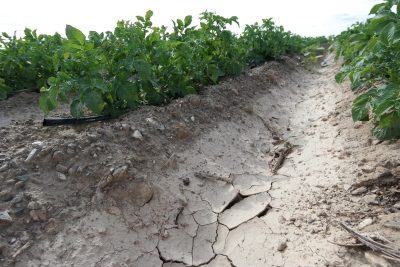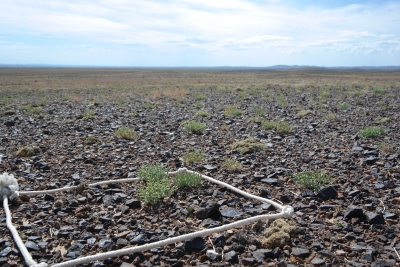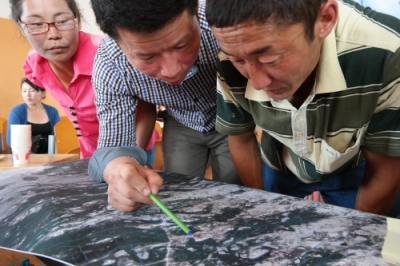Clusters
To make project management more efficient, Mongolian, Chinese and German scientists will team up in five different thematic clusters each contributing to nine Work Packages.
Clusters
This project component will quantify the available water resources at different spatial and temporal scales and develop effective environmental indicators (water balance, water quality, water use efficiency of rangeland plants, the traditional wheat crop, certified organic buckthorn, and greenhouse vegetables) for this most critical resource. This information will be used to develop adaptive water use options and to strengthen transborder water planning policies including access rights / restrictions.
For results within this cluster check following publications (to be continued):
In English
Water Use Efficiency of Different Crops in Qinghe (Poster)
- Irrigation system in the Bulgan river basin, Mongolia (Poster)
Responsible scientists
Mongolia: Soninkhishig
China: Ju, Tian
Germany:

This project component will analyse crop growth, soil carbon and nutrient fluxes as determinants of land use sustainability. These data will allow identifying sustainable pasture and crop management practices for extension services and formulation of policy recommendations.
For results within this cluster check following publications (to be continued):
In English
- Soil microbial indicators for different land-use types in the oasis Bulgan Sum, Mongolia (Masterthesis)
Effects of deposition on different landuse types in semi-desert ecosystems of the Altay Mountains (Poster)
- Nutrient cycling in agricultural production systems in Bulgan Sum, Mongolia (Poster)
In Mongolian
- Булган сумын газар тариалангийн систем дэх шим тэжээлийн бодисын эргэлт (Poster)
In Chinese
- 阿尔泰山及准噶尔盆地边缘半荒漠系统不同土地利用方式的氮沉降量及其生态效应 (Poster)
Responsible scientists
Mongolia: -
China: Feng, Zhang-Fusuo
Germany: Buerkert, Joergensen, Ludwig

This project component will assess responses of rangeland vegetation to changing environmental conditions and anthropogenic pressure related to livestock husbandry. Current resource use of livestock herds as affected by altitude, land use intensity, herd composition and management will be compared to alternative approaches. Results will foster the development of sustainable livestock management practices and policies.
For results within this cluster check following publications (to be continued):
In English
Plant communities along the altitudinal gradient of Bulgan river Basin (Proceeding)
- Allium carolinianum DC. - a new species in Mongolia (Proceeding)
- Notes on the new finding - Lythrum virgatum (Proceeding)
- Vegetation community of Bulgan river Basin (Masterthesis)
Laurel Poplar (Poplar laurifolia L.)–Genetic diversity of a vulnerable population in Western Mongolia (Poster)
Sustainable livestock production in transhumant grazing systems in the Chinese Altai Mountains (Poster)
Impact of grazing intensity on herbage mass, live weight gain and grazing behavior on meadow steppe of Altai mountain, China (Poster)
Herd management and livestock productivity in Altai mountain of western Mongolia: role of seasonal mobility (Poster)
- Predictive mapping of plant communities in Bulgan river basin (Poster)
In Mongolian
- Булган голын сав газрын ургамлын бүлгэмдэл болон зураглал (Poster)
Монголын Алтайн уул дахь мал маллагааны менежмент түүний бүтээгдэхүүн үйлдвэрлэл дэх улирлын нүүдлийн үүрэг (Poster)
In Chinese
- 放牧强度对阿尔泰山山地草甸草原牧草产量、牲畜生产及放牧行为的影响 (Poster)
- 中国阿勒泰山游牧生态系统畜牧业可持续生产的研究 (Poster)
Responsible scientists
Mongolia: Oyuntsetseg, Togtokhbayar
China: Zhang-Ximing
Germany: Schlecht, Wesche

This project component will provide economic and institutional data about household land and natural capital use, livelihood strategies, production activities and respective attitudes and preferences. A monetary valuation of central non-market ecosystem services will be obtained using stated preference data (‘Choice Experiment’), followed by livelihood-specific identification and valuation of critical natural capital using non-market valuation data and household baseline data. An adapted SIAT will be used to predict how alternative livelihood strategies enable stakeholders to cope with anticipated change in pasture productivity, climate-related temporal shifts in water availability and socio-economic changes. A PAM study will assess the private and social competitiveness of key agricultural production activities, their dependence on regional and national policies, changes on global agricultural product markets, and the availability of ESS&F. This approach will also provide input into models used by the World Bank for Impact Modeling.
For results within this cluster check following publications (to be continued):
In English
Germination of licorice seeds from Bulgan river basin, Mongolia (Poster)
Indigenous knowledge of medicinal plants used in the Altay-Dzungarian region of Mongolia (Proceeding)
Competitiveness of livestock production in Mongolia using Policy Analysis Matrix approach (In case of Bulgan soum Khovd province) (Poster)
In Mongolian
Бодлогын шинжилгээний материцыг ашиглан МАА-н бүтээгдэхүүн үйлдвэрлэлийн өрсөлдөх чадвар (Ховд аймгийн Булган сум) (Poster)
Responsible scientists
Mongolia: Lkhagvadorj
China: Zhang-Xinhuan
Germany: Barkmann, von Cramon-Taubadel
